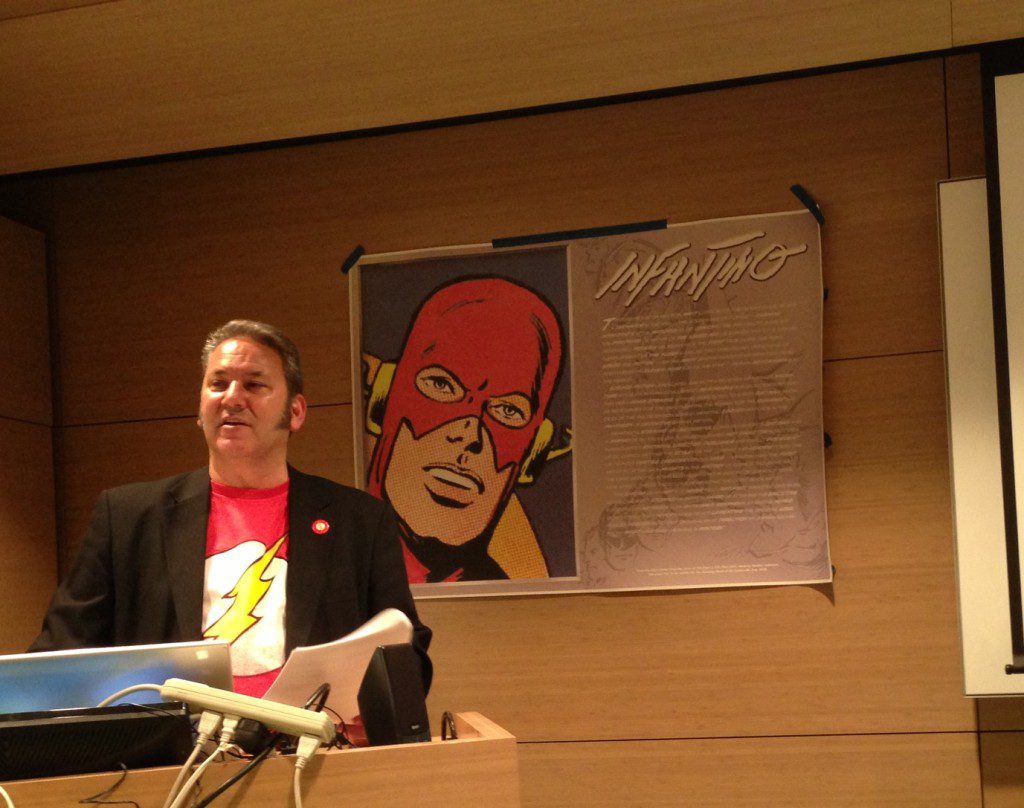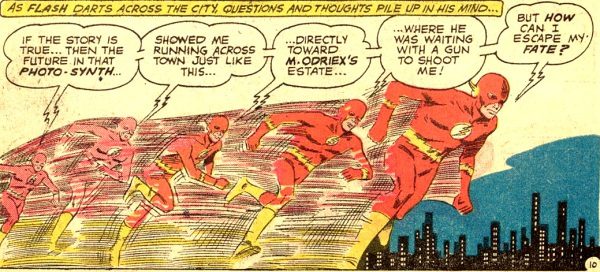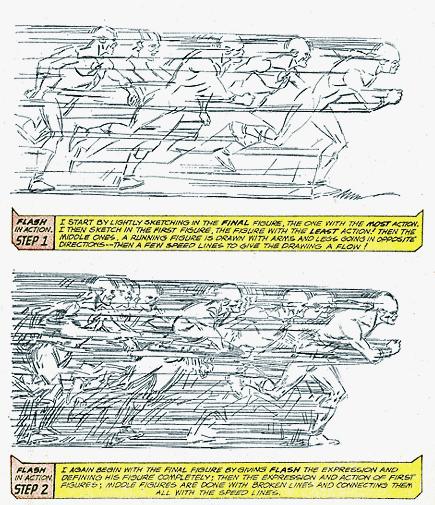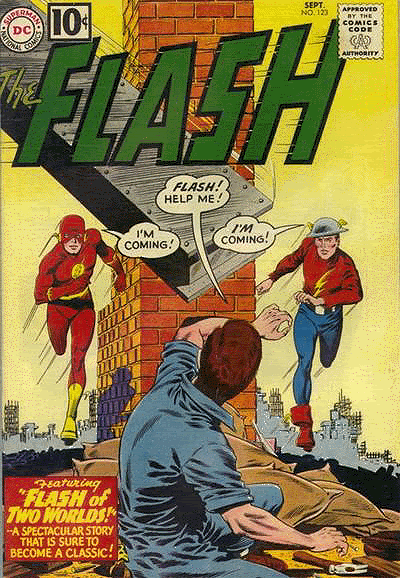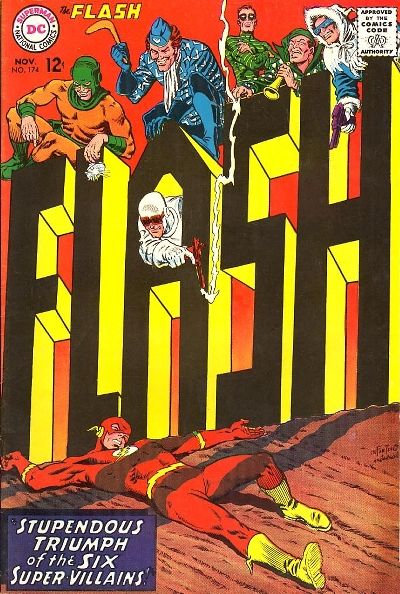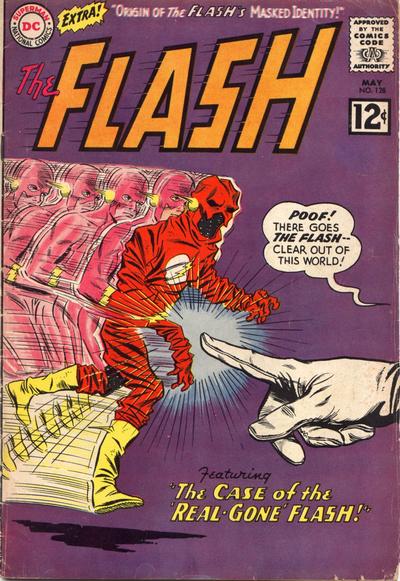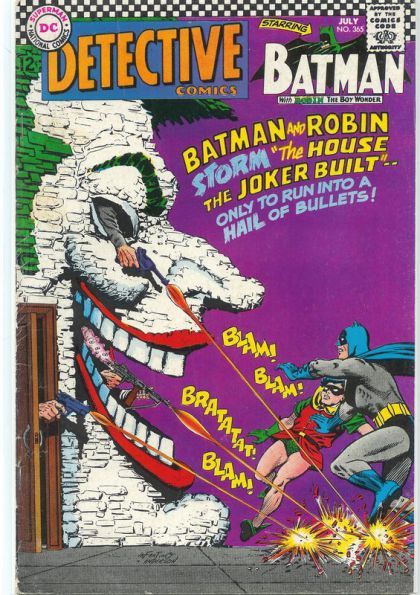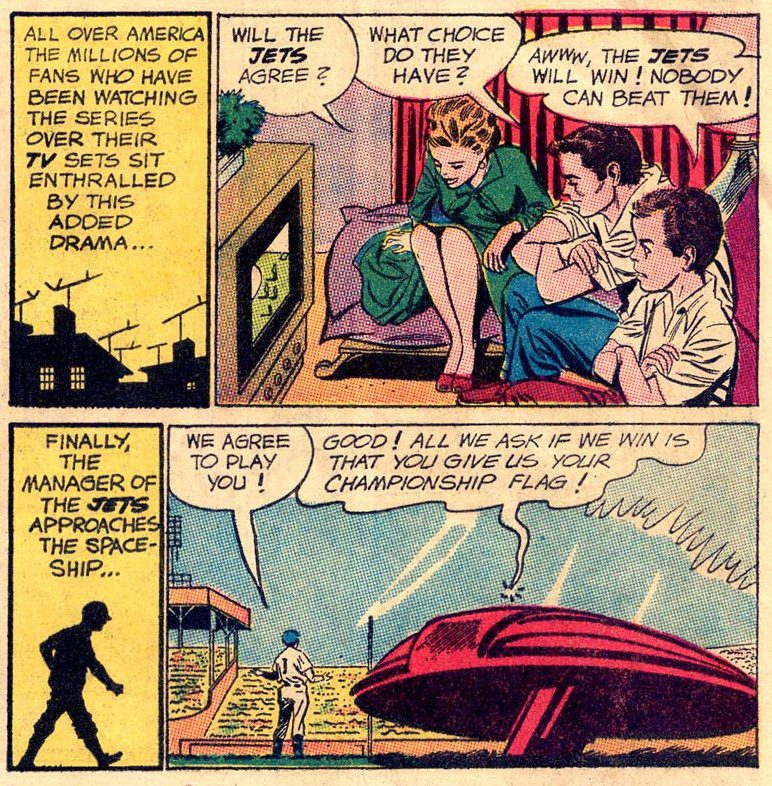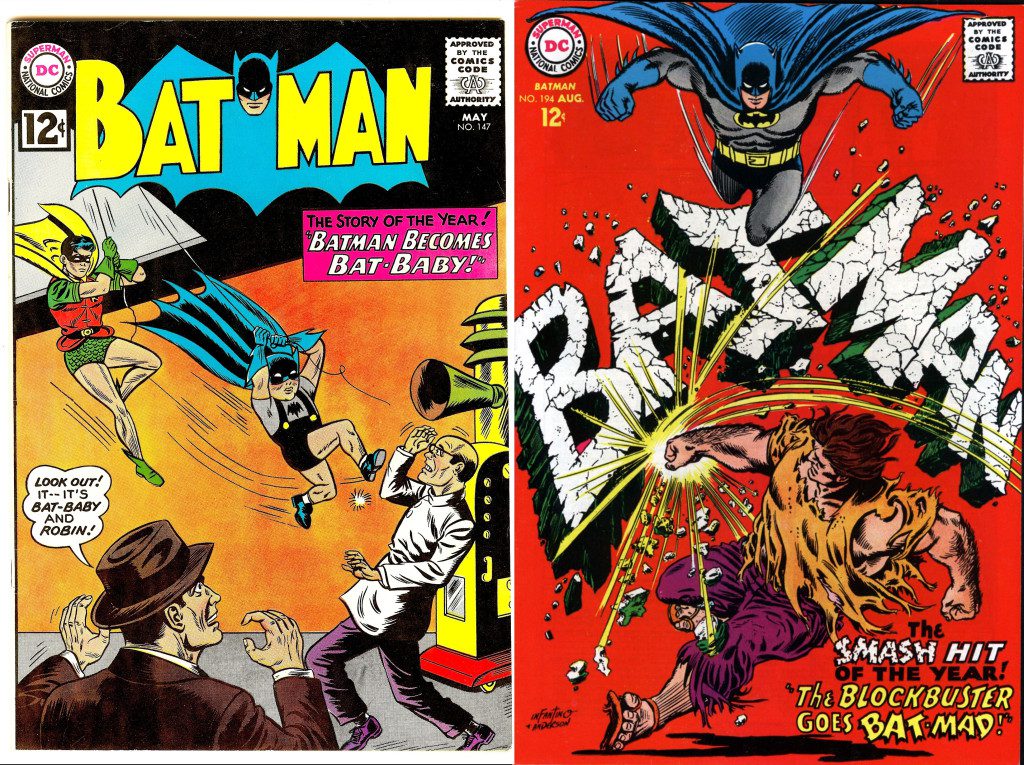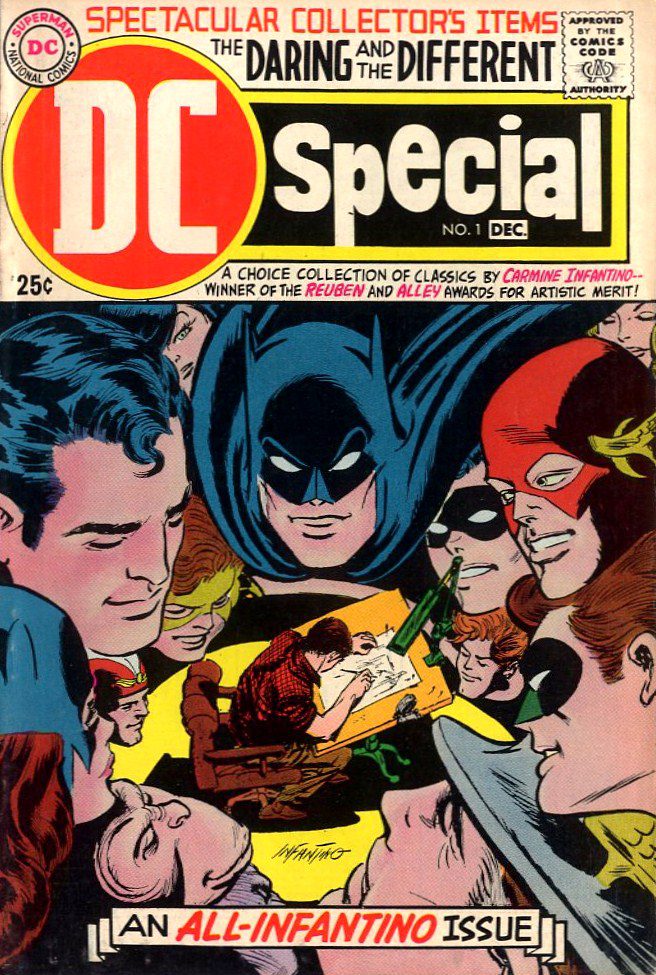The New York Comics & Picture-Story Symposium is a weekly forum for discussing the tradition and future of text/image work. Open to the public, it meets Monday nights 7-9pm EST in New York City. Presentations vary weekly and include everything from historical topics and technical demonstrations to creators presenting their work. Check out upcoming meetings here.
Comic-book historian Arlen Schumer gave one of his signature VisuaLectures on the legacy of recently deceased DC artist and editor Carmine Infantino. You can watch a recording of the presentation here. Starting off with Infantino’s legendary run on The Flash, Schumer took us through the artist’s career at DC, highlighting his innovative style and his contributions to Silver Age comics.
Infantino’s unique and breathtaking technique for depicting movement brought new life to the Silver Age Flash. Schumer pointed out how Infantino used long horizontal panels to emphasize Flash’s speed, and how he drew The Flash moving differently each time to keep the motion interesting. Comparing Duchamp’s Nude Descending a Staircase and Infantino’s art, Schumer discussed the parallels between techniques used in fine art and Infantino’s comics. This dialogue between paintings and comics came up several times during the evening, as Schumer pointed out how Infantino drew inspiration from Degas and Modigliani for depicting the figure.
Infantino showed the full force of his talent when drawing The Flash. All of these hallmarks would also appear in the other titles he worked on during his tenure at DC: his incredible design sense, his virtuosity with the figure, his definition of space and architecture, and his ability to draw whimsical images in a plausible way. He created dynamic, striking covers using strong diagonal elements, symmetrically balanced planes, dramatic type, and brilliant figure drawing. Schumer presented many examples, as seen on covers for The Flash, Mystery in Space (starring Adam Strange), Batman, Superman, and Elongated Man.
The artist’s detailed architecture and natural landscapes, whether drawn for a contemporary setting or a science-fiction universe, were vital tools for world building. Although inking was also close to Infantino’s heart, most of his work was done in collaboration with his “soulmate inker,” Murphy Anderson. When Infantino did ink his own pencils, his line brought a loose, dynamic energy to the drawings.
Noting how Infantino’s artistic ability let him “pull off realistic and abstract at the same time,” Schumer discussed covers and panels that pushed into the surreal: The Flash transformed into a puppet, The Flash’s lifelike (and slightly sinister) disembodied suit talking to Barry Allen, Batman and Robin using the Riddler like a punching bag, and the remarkable scene on the cover of “The House the Joker Built.” On their own, these setups might strain credulity. Yet Infantino’s skillful rendering and dramatic composition make them not only plausible, but also compelling. Schumer isolated a panel from an Adam Strange comic where the hero mourns the death of his lover. The strong negative space and horizontal plane emphasize Strange’s desolation.
In other comics, Infantino played with compositional elements to tell stories. For instance, in DC’s series The Brave and the Bold: Strange Sports Stories, he would begin a tier with short, silhouetted panels, then continue it with a longer, more detailed panel, thus setting up the suggestion of a form (a setting, a spacecraft, etc.) and offering a payoff in the subsequent panel. “He considered it a form of animation,” Schumer said. He also interspersed panels showing action with short panels of isolated hands making gestures. Coupled with narration, these panels break up the sports action and tell the story in a completely novel way.
Following Infantino’s work on Adam Strange, DC asked him to rescue Batman comics, which by the early 1960s were in danger of being discontinued. Drawn in a clunky, blocky style and featuring ridiculous plot lines, the series had lost much of its mystery and excitement. Infantino brought his artistic gifts to bear on Batman’s covers, and you can see the dramatic difference between pre- and post-Infantino covers below:
These covers injected new life into the series—although other artists drew the interiors in the same clunky style that had landed the series in so much trouble. By 1966, a new Batman craze hit popular culture, thanks in part to the TV show starring Adam West. The show needed more female characters, so Infantino designed Batgirl and Poison Ivy. (He had previously helped create Black Canary in 1947). DC promoted the comics’ new artwork as a selling point.
Having rejuvenated Batman and created Deadman, Infantino was at the height of his powers. But he stopped drawing comics so he could become an editorial director (and later a publisher) at DC. It was a remarkable instance of an artist becoming an executive, and it had a great impact on DC comics. Infantino nurtured artists, hiring Dick Giordano and making Joe Kubert an editor. He encouraged Neal Adams’ career, and brought the rights for Tarzan, The Shadow, and Captain Marvel to DC. He also oversaw Famous First Editions comics, a series that educated readers on comics history by reproducing first editions of major series.
In 1976, DC let Infantino go. He returned to freelance art; while his work was still good, it couldn’t match the brilliance of his earlier years. Schumer concluded by talking about the incredible debt comics readers and artists owe Infantino.
During the Q&A, Schumer talked more about Infantino’s relationship with his inker, Murphy Anderson, and how they each needed each other to make great work, despite a generally stormy relationship. He also pointed out the irony of how creators like Infantino produced incredible art but never thought of themselves as artists. How could they, when DC had a policy of destroying its original art? Schumer shared an anecdote about how DC continued this policy until Neal Adams lost his temper one day with a man shredding the art, and DC finally acquiesced. “How great of an artist would you have to be to be able to produce art at that level and yet think your stuff is [crap]?” Schumer said. He concluded by saying that “we’re the beneficiaries” of this amazing work, and that future art historians would think of comics art the same way we think of Renaissance paintings today.
***
Image 1: Andrea Tsurumi, Photo of Arlen Schumer, 2013
Image 2: Carmine Infantino, The Flash #116, DC Comics, 1960
Image 3: Carmine Infantino, How I Draw The Flash, 1963
Image 4: Carmine Infantino, The Flash #123, DC Comics 1961
Image 5: Carmine Infantino, The Flash #174, DC Comics, 1967
Image 6: Carmine Infantino, The Flash #128, DC Comics, 1962
Image 7: Carmine Infantino, Detective Comics Vol. 1 #365 cover, DC Comics, 1967
Image 8: Carmine Infantino, Mystery in Space #78, DC Comics, 1962
Image 9: Carmine Infantino, The Brave and the Bold #45, DC Comics 1962
Image 10: Sheldon Moldoff, Batman Vol. 1 #147, DC Comics, 1961
Image 11: Carmine Infantino, Batman Vol. 1 #194 cover, DC Comics, 1967
Image 12: Carmine Infantino, Batman Vol. 1 #171 cover, DC Comics, 1965
Image 13: Carmine Infantino, DC Special Vol. 1 #1, DC Comics, 1968
****
About the author: Andrea Tsurumi is an illustrator and cartoonist recently graduated from SVA’s Illustration MFA program. You can see her work here and check out her latest projects here. She lives in Astoria with fellow cartoonist Alexander Rothman.

